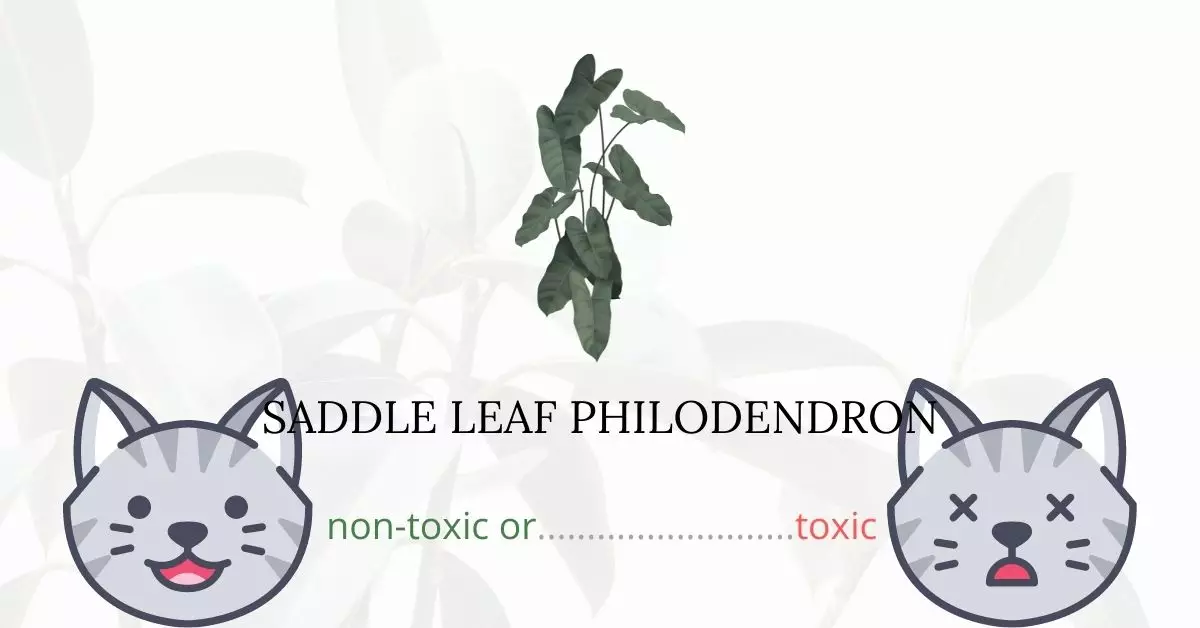The Saddle Leaf Philodendron is indeed toxic to cats, presenting a significant risk if ingested.
This article, which provides a direct response to the question at hand, has been crafted with the insight and expertise of a team of experienced Doctors of Veterinary Medicine (DVMs). Their valuable contributions enable us to deliver precise and current information regarding the potential hazards posed by different plants, including the Saddle Leaf Philodendron, and their impacts on cats. Moreover, we have meticulously researched high-authority websites like ASPCA and PetMD to corroborate our findings on every plant mentioned, ensuring the reliability of the information presented.
To elaborate, the Saddle Leaf Philodendron, akin to its plant relatives in the Araceae family, contains insoluble calcium oxalates. When a cat chews on this plant, it encounters these oxalates within a specific cell, the idioblast. The cat’s saliva prompts the gelatin inside to expand, leading to the rupture of the idioblast and releasing calcium oxalate crystals violently. These crystals embed themselves deeply into the cat’s skin, mouth, and tongue, causing discomfort and potential health issues.
Clinical Signs of Saddle Leaf Philodendron Poisoning in Cats
When cats interact with or consume the Saddle Leaf Philodendron plant, a range of clinical signs may manifest due to the plant’s toxicity. Ingesting any part of this plant, particularly the leaves and stems, can be perilous, with the risk intensifying in correlation with the amount consumed. Here, we will elucidate each clinical sign, providing insight into the reasons behind their occurrence when cats come into contact with, smell, or ingest the Saddle Leaf Philodendron plant.
- Inflammation of the Mouth: Ingesting the plant can cause inflammation in the cat’s mouth due to the release of calcium oxalate crystals which can embed themselves in the mouth’s soft tissue, leading to irritation and inflammation.
- Intense Sensation in the Mouth, Tongue, and Lips: The embedded crystals can trigger an intense burning and stinging sensation in the mouth, tongue, and lips, causing substantial discomfort to the cat.
- Hypersalivation: The irritation and intense sensation induced by the crystals prompt an increase in saliva production as the body’s natural response to try and alleviate the irritation, resulting in hypersalivation.
- Difficulty Swallowing: The inflammation and irritation in the mouth and throat can hinder the cat’s ability to swallow, making the ingestion of food or water challenging.
- Vomiting: If the plant is ingested, the body will attempt to expel the toxic elements, leading to vomiting, which is a clear sign of distress and poisoning.
- Choking: The swelling and irritation in the throat can obstruct the airway, leading to choking, which can be life-threatening if not addressed promptly.
- Swelling: The body’s natural response to the embedded crystals is to increase blood flow to the affected area, causing swelling in an attempt to isolate and deal with the irritant.
Vigilance is crucial when observing a cat that has been in contact with the Saddle Leaf Philodendron plant. Immediate veterinary attention is paramount if any of these symptoms are observed, as early intervention can be pivotal in managing the severity of the reaction and ensuring the well-being of the cat.
First Aid and Treatment of Saddle Leaf Philodendron Poisoning in Cats
If your cat has been suffering from severe vomiting and diarrhea, your vet may give him intravenous fluids to help her rehydrate. Oral antihistamines may assist to reduce any edema induced by the plant and its toxins.
Kapectolin, which covers and protects the stomach lining, may be prescribed by your veterinarian for stomach distress. Sucralfate, which reacts with your cat’s stomach acids to produce a protective paste in her stomach, may also be given to her. If your cat has trouble breathing due to airway swelling, the vet will need to observe him closely until his condition stabilizes.
Recovery from Saddle Leaf Philodendron Poisoning in Cats
Most cats who suffered from poisoning cases due to ingestion of a saddle leaf philodendron recover fully after treatment. The speed of recovery depends on the quantity of the plant consumed by the feline. Give your cat ample time to rest at home after receiving treatment.
Prevention of Saddle Leaf Philodendron Poisoning in Cats
Remove any saddle leaf philodendron inside your house and in your gardens. Limit your cat’s outdoor activities by keeping them occupied and mentally stimulated indoors. This will reduce the chance of wandering outside and encountering toxic plants in the neighborhood.
If you love plants but have cats at home, check out these lists:





